Claude Skills Part 3: How to Make Claude Code Master Any Library in 15 Minutes (Even If It Launched Yesterday)
Let’s say you’re sitting there at 2 AM.
You’ve just discovered this game-changing AI Elements library—launched recently, perfect for what you need. Your brain is doing that excited thing where it’s already building the feature before your fingers touch the keyboard.
You fire up Claude Code.
Type with the confidence of someone who’s done this a thousand times: “Build me an AI chat interface using AI Elements.”
Claude starts coding.
It looks… plausible.
Convincing, even.
Then you spot it: import { AIChat } from '@ai-sdk/elements'
That import doesn’t exist. The component is called Conversation. Claude is hallucinating an API that sounds right but isn’t.
It’s writing fiction dressed up as code.
You correct it.
Claude apologizes—sweet, polite, completely unhelpful.
Tries again.
Different hallucination.
Round and round you go.
Like trying to teach someone to cook while they’re blindfolded and you’re speaking different languages.
The documentation is literally right there on your screen. But Claude can’t see it.
Well.
That used to be true.
.
.
.
Here’s the Thing About AI and Documentation
Every week—every blessed week—new libraries launch.
The ones you already use? They’re dropping breaking changes like confetti at a wedding nobody wanted to attend.
Meanwhile, your AI coding agent is stuck in the past.
Claude Opus 4.1 doesn’t know about the library that launched last month. It definitely doesn’t know about the v2.0 that dropped while you were eating lunch yesterday.
(Is it weird that we expect AI to be omniscient? Like it should somehow absorb knowledge through the ethernet? Stay with me.)
You’ve probably tried the usual suspects:
- The copy-paste marathon—where you dump documentation into the prompt until your context window explodes like an overfilled water balloon.
- The MCP server hunt—searching for something that usually doesn’t exist. (Spoiler: it doesn’t.)
- The Context7 lottery—sometimes brilliant, sometimes returns docs from the Mesozoic era.
- The manual correction dance—where you become a human API reference for three hours. (Fun!)
Each approach fails spectacularly in its own special way.
- Copy-pasting burns through 80% of your context before you write a single line of actual code. Good luck debugging when you’ve already consumed 100k tokens on documentation alone.
- MCP servers are amazing. When they exist. Which is approximately never for the library you need right now.
- Context7 is like a box of chocolates—you never know if you’re getting current docs or something from 2022. You’ll find out the hard way.
- Manual correction? Sure, if your idea of a good time is playing “human API dictionary” until your eyes bleed.
There had to be a better way.
(There is.)
.
.
.
Enter Claude Skills: Your Documentation Superpower
Imagine this: You could teach Claude ANY library’s documentation.
Permanently.
Not the copy-paste-and-pray method. Not the please-let-there-be-an-MCP-server wishful thinking.
Actual knowledge.
The kind Claude can reference intelligently, pulling only the relevant bits for each task.
Like having a senior developer who’s memorized every documentation page but only shares what you need to know right now.
Here’s what becomes possible:
Claude Skills package documentation in a way that makes Claude understand not just WHAT the API is, but HOW to use it correctly. The difference between knowing the words to a song and understanding why it makes people cry.
Once you create a skill, it works forever.
Every project.
Every session.
Perfect implementation every time.
(Is it magic? Kind of. But the boring, repeatable kind.)
Let me show you exactly how I turned brand-new AI Elements documentation into a Claude Skill. Then used it to build a complete AI chat application.
Without a single hallucination.
Ferpetesake, it actually worked.
.
.
.
Step 1: Gather Your Documentation (2 Minutes, If You’re Slow)
I started at ai-sdk.dev/elements.
Downloaded everything—component references, examples, tutorials, the works.
Dropped them in my project like this:
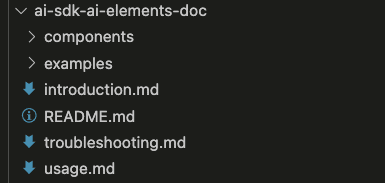
Here’s the thing: Grab everything. Even that weird edge-case page you think you’ll never need. That’s the page that’ll save your bacon at 3 AM when nothing else makes sense.
(Trust me on this one.)
.
.
.
Step 2: Brainstorm Like You Mean It (5 Minutes)
Most people would jump straight into creating the skill here.
Don’t.
(Seriously. Stop. Put down the keyboard.)
First, you need to define exactly how you want Claude to use this documentation. Think of it like training a brilliant but literal-minded assistant—you need to be specific about expectations.
Here’s my exact prompt:
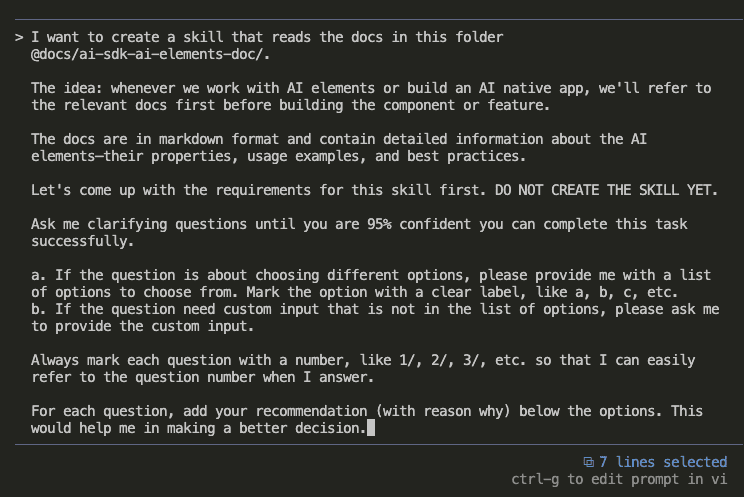
Prompt:
I want to create a skill that reads the docs in this folder @docs/ai-sdk-ai-elements-doc/. The idea: whenever we work with AI elements or build an AI native app, we'll refer to the relevant docs first before building the app. The docs are in markdown format and contain detailed information about the AI elements SDK including usage examples, and best practices. Ask me clarifying questions until you are 95% confident you can complete this task successfully. a. If the question is about choosing different options, please provide me with a list of options to choose from. Mark the option with a clear label, like a, b, c, etc. b. If the question need custom input that is not in the list of options, please ask me to provide the custom input. Always mark each question with a number, like 1/, 2/, 3/, etc. so that I can easily refer to the question number when I answer. For each question, add your recommendation (with reason why) below the options. This would help me in making a better decision.
Watch what happens next.
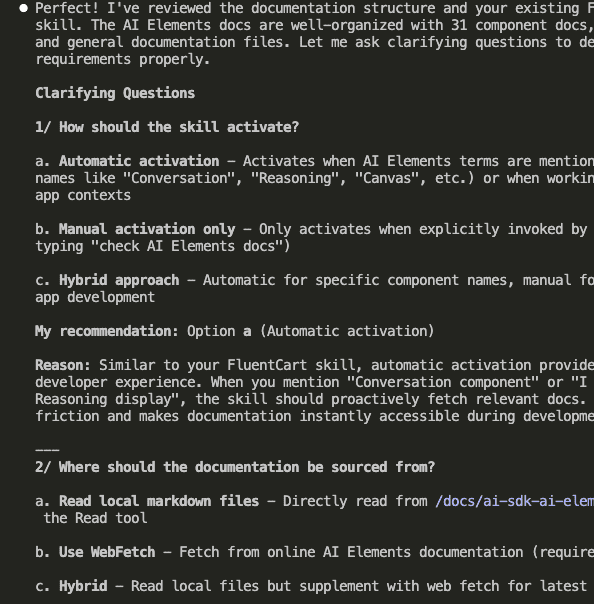
Claude doesn’t just accept the task like an overeager intern. It asks targeted questions:
How should the skill activate?
- Automatic (when AI Elements terms pop up)
- Manual only (when you explicitly call it)
- Hybrid (best of both worlds)
Where should documentation live?
- Local markdown files
- WebFetch from the mothership
- Both (local with web backup)

I answer with quick picks. No dissertations needed.
Claude then creates a complete requirements document.
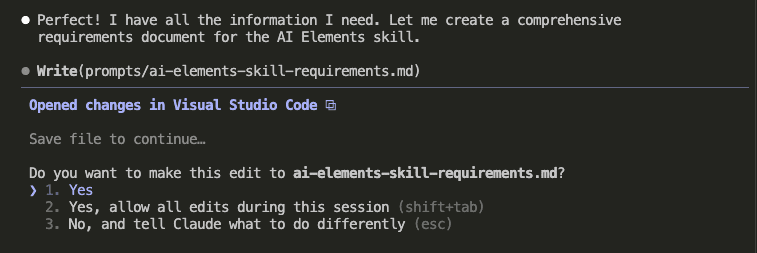

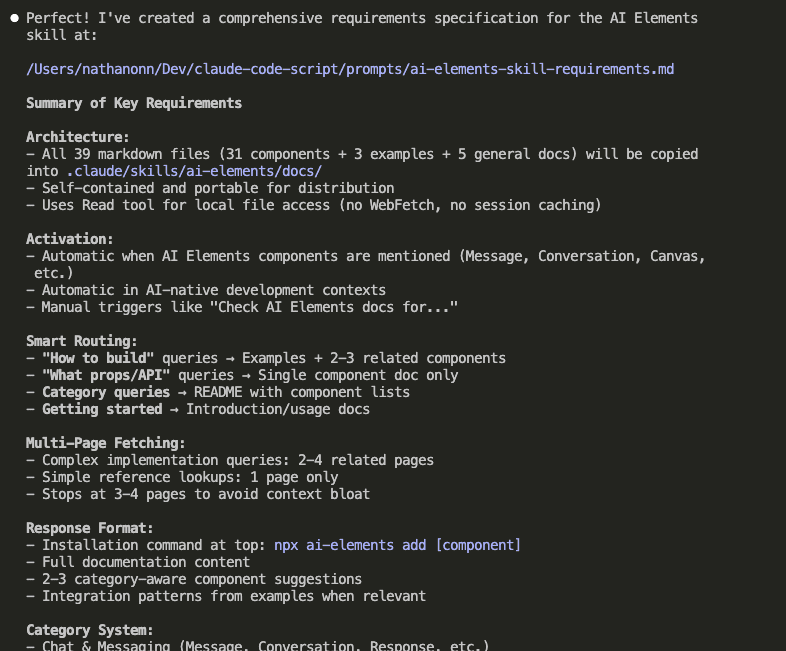
We’re talking 654 lines of specifications. It includes:
- Activation triggers (automatic when components are mentioned—like a helpful friend who knows when to chime in)
- 4 intelligent routing modes
- Smart multi-page fetching rules
- Response format templates
- Query interpretation patterns
This isn’t busy work.
This is Claude learning HOW you want it to think about this documentation.
Time invested: 5 minutes of Q&A.
(Worth every second.)
.
.
.
Step 3: Transform Requirements Into Reality (3 Minutes)
Now for the satisfying part.

I tell Claude: “Let’s use the ‘skill-creator’ skill to create the skill”
(Yes, we’re using a skill to create a skill. It’s skills all the way down. Stay with me.)

Watch as Claude:
- Packages all 39 markdown files (31 components plus the kitchen sink)
- Creates intelligent routing rules
- Builds activation triggers
- Generates a searchable index




The result?
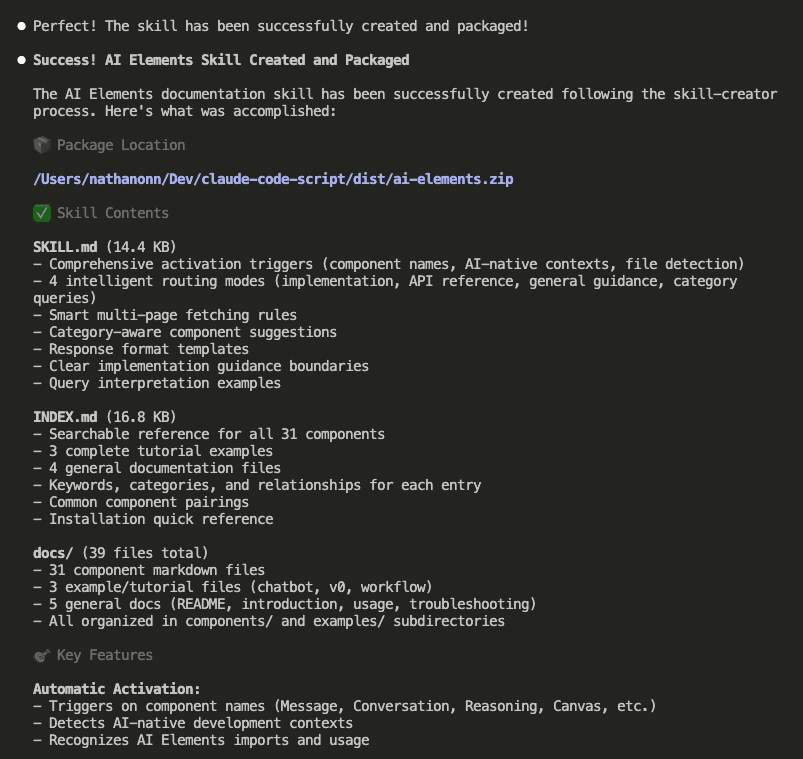
Your documentation is now a reusable Claude Skill.
Forever.
(Take a moment. This is big.)
.
.
.
Step 4: Watch the Magic Happen (10 Minutes of Pure Joy)
Time to see if this actually works.

I tell Claude: “Read the @.notes/requirements.md, and use the ‘ai-elements’ skill to build the AI Chat Application.”
Claude recognizes the skill immediately:

Now here’s where it gets interesting.
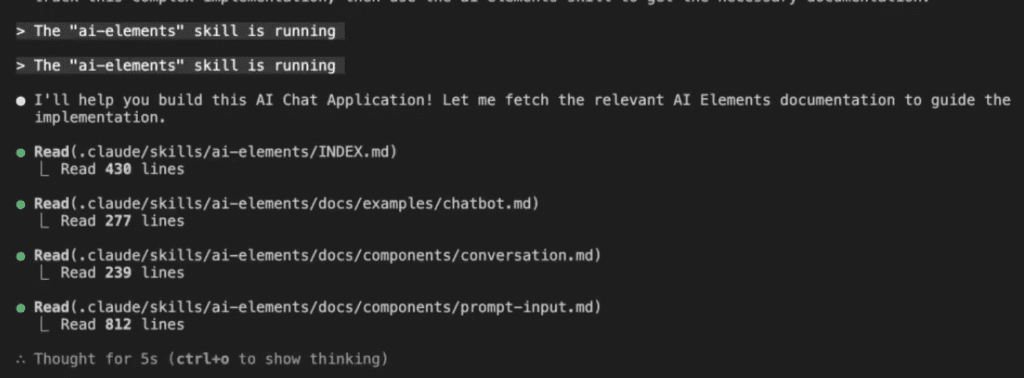

Instead of guessing the API—or worse, making stuff up—Claude reads the actual docs:
INDEX.mdfor component referenceexamples/chatbot.mdfor patternscomponents/conversation.mdfor core componentscomponents/prompt-input.mdfor input handling
Notice something?
Claude read 8 files out of 39. Not the entire documentation set. Just what it needed.
Surgical precision.
(This is the opposite of the copy-paste-everything approach. And it’s beautiful.)
Now Claude builds with the confidence of someone who actually knows what they’re doing:
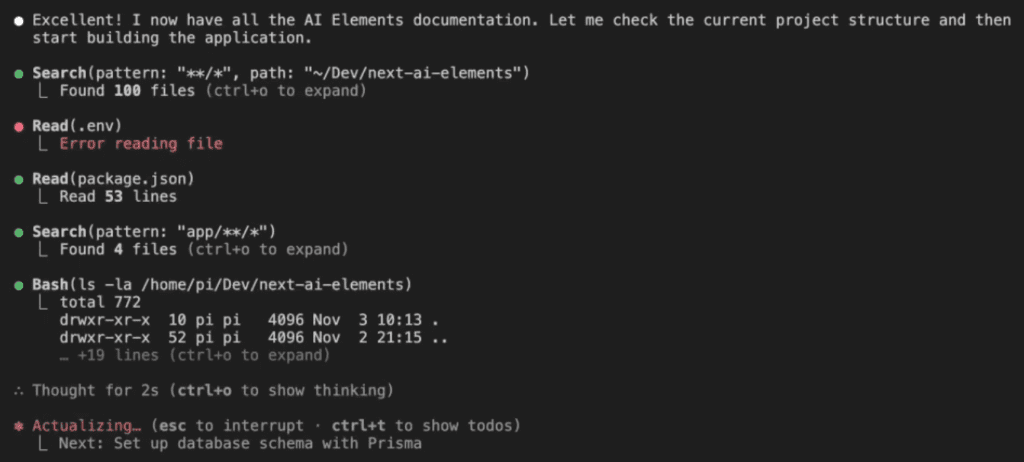

Every import correct. Every API call accurate. Zero hallucinations.
Want proof this actually works? Here’s what I built:

The entire AI chat application builds perfectly:
- Database schema with Prisma
- API routes for chat sessions
- Real-time streaming with AI Elements
- Proper component composition
- Error handling
- State management
No back-and-forth. No corrections. No “actually, that’s not how it works.”
It. Just. Works.
(I may have done a small victory dance. Don’t judge.)
.
.
.
Why This Isn’t Just Another MCP Alternative
“But wait,” you’re thinking. “Isn’t this what MCP servers do?”
Kind of. But also not at all.
MCP servers:
- Require the library author to build one (good luck with that)
- Need constant maintenance (who has time?)
- Often lag behind latest versions (naturally)
- You have zero control (hope you like their choices)
Claude Skills:
- You create them yourself (15 minutes, tops)
- Work with ANY documentation (even that obscure library from 2019)
- Update when YOU want (not when someone else gets around to it)
- Full control over what’s included (your docs, your rules)
But here’s the feature that makes me want to write poetry:
Claude Skills read intelligently.
When working with AI Elements, Claude didn’t inhale all 39 documentation files like some kind of context-window glutton. It read the 8 relevant ones. No waste. No bloat. Just what it needed.
Try that with copy-paste.
(Spoiler: you can’t.)
.
.
.
The Compound Effect (Or: Why This Changes Everything)
Think about your current stack for a hot second:
- React components library
- Your database ORM
- Payment provider SDK
- Authentication library
- UI component system
- Analytics platform
- Email service
- File storage API
- That weird library Bob insisted on using
Each one could be a Claude Skill.
Do the math with me:
1 library skill = 2 hours saved per project 10 library skills = 20 hours saved Your entire stack as skills = Never manually correct AI again
But wait. (There’s more.)
- Version updates? Update the skill once. Every project gets the new version. Like magic, but boring and reliable.
- Team knowledge? Share the skill. Everyone codes like they wrote the docs. Instant expertise, just add water.
- New libraries? 15 minutes to perfect implementation. Even if it launched during your lunch break.
.
.
.
Your Library Skills Arsenal: A Field Guide
The Golden Rules
Rule 1: Include Everything, Let Claude Filter
Don’t try to curate “only the important docs.” You’re not the documentation police.
Claude Skills are intelligent. They’ll find what’s relevant. Your job is comprehensive coverage. Be the completionist.
Rule 2: Update Regularly (Set a Calendar Reminder)
Monthly skill updates. Put it in your calendar. Title it “Feed the Skills.” Your future self will send you thank-you notes.
Rule 3: Create Composite Skills
Building with Next.js + Prisma + tRPC? Create a “nextjs-stack” skill with all three. One activation, complete stack knowledge.
(Why make three trips when one will do?)
Rule 4: Test in Isolation
Before using a library skill in production:
- Create a simple test project
- Ask Claude to build a basic example
- Verify the generated code matches current docs
Trust, but verify.
Rule 5: Share Your Skills
That React Native Navigation skill you perfected? Your team needs it. That Stripe integration skill? The community wants it.
Build once. Help everyone.
(Be the hero.)
.
.
.
Your Action Plan (Do This Today)
Step 1: Identify Your Most Frustrating Library
Which one causes the most AI hallucinations?
- That new API you’re wrestling?
- The library with the major update?
- The complex SDK with 100+ endpoints?
Pick your nemesis.
Step 2: Gather Documentation (2 minutes)
Download or clone the docs. Create a folder. Done.
(Easier than making coffee.)
Step 3: Brainstorm Requirements (5 minutes)
Use my prompt. Answer the questions. Let Claude build comprehensive requirements.
No shortcuts here. Do the work.
Step 4: Create The Skill (3 minutes)
Run skill-creator. Package the documentation.
Watch as months of frustration evaporate.
Step 5: Test Immediately
Build something simple. Verify accuracy. Refine if needed.
(But honestly? It usually works perfectly the first time.)
Step 6: Use It Everywhere
Every project. Every feature. Perfect implementation.
No exceptions.
.
.
.
The Future You’re Building (Whether You Know It Or Not)
Picture this: You open Claude Code six months from now.
Your skills library includes:
- Every major framework (even the ones that don’t exist yet)
- Your company’s internal SDKs (the undocumented ones)
- That obscure library only you use (we all have one)
- The cutting-edge tool that launched this morning
You type: “Build me a real-time collaborative editor with our standard stack”
Claude activates:
- nextjs-15-skill
- collaboration-sdk-skill
- your-ui-components-skill
- websocket-patterns-skill
Perfect implementation. First try. Every single time.
No more “Claude doesn’t know this library.”
No more debugging hallucinated APIs.
No more being a human API reference.
Just your documentation, permanently accessible, intelligently used.
(Is this what peace feels like?)
.
.
.
Here’s What I Know to Be True
Every library you use regularly should be a Claude Skill.
Not because it’s trendy. Not because it’s the cool new thing. Not even because I said so.
Because spending 15 minutes creating a skill saves you hours of correction. Forever.
Because your team deserves consistent implementation without the learning curve.
Because you have better things to do than correct AI hallucinations all day.
(Like, literally anything else.)
Claude Skills aren’t just about saving time. They’re about eliminating an entire category of AI coding friction. The kind that makes you want to throw your laptop out the window.
So here’s my challenge:
Take that new library. The one with no MCP server. The one Claude keeps getting wrong. The one that’s been making you question your career choices.
Spend 15 minutes. Create the skill. Watch it work perfectly.
Then ask yourself:
Why would you ever go back to the old way?
Stop correcting hallucinations.
Start building with confidence.
Right now.
(Seriously. What are you waiting for?)
Resources:
Leave a Comment